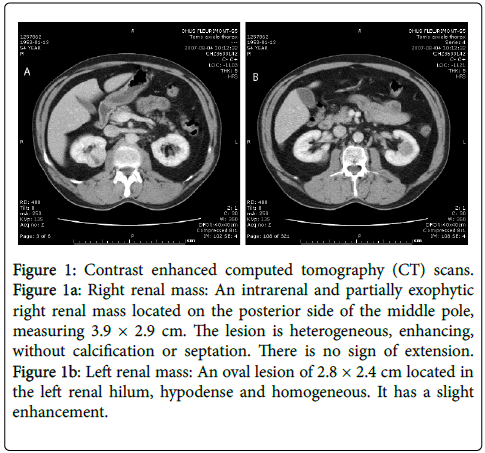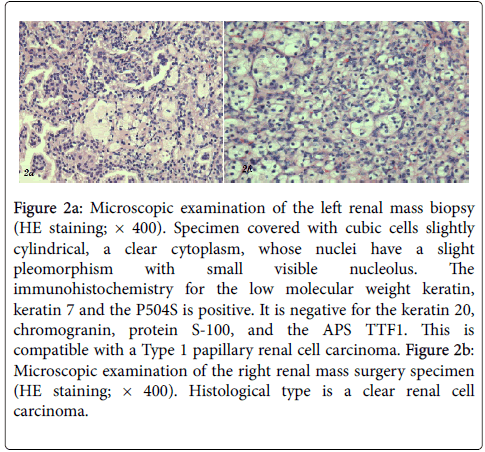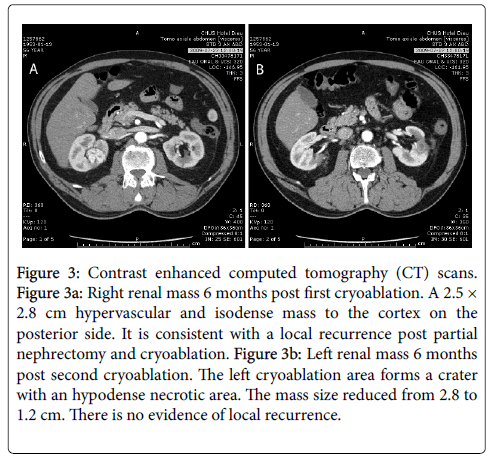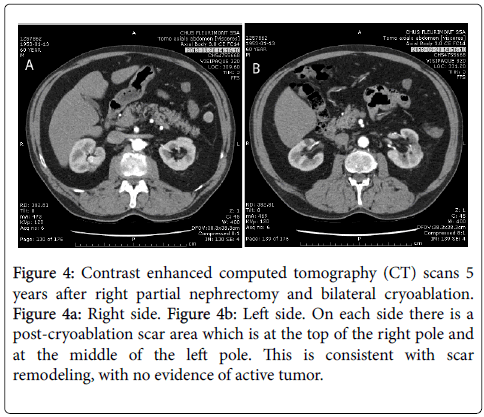Bilateral Renal Masses with Different Histopathology Subtypes Treated by Laparoscopic Right Partial Nephrectomy and Bilateral Cryoablation-Results at 5 Years Follow-Up
Received: 02-Oct-2015 / Accepted Date: 10-Nov-2015 / Published Date: 15-Nov-2015 DOI: 10.4172/2476-2024.1000101
Abstract
We present the case of a 54 year old man with a synchronous mass on each kidney with different renal cell carcinoma (RCC) subtypes and a normal renal function. He categorically refused to undergo radical nephrectomy and open partial nephrectomies. He underwent a laparoscopic right partial nephrectomy and then percutaneous CTguided bilateral cryoablation. A second percutaneous CT-guided course of cryoablation on the right mass was performed at 6 months post cryoablation for recurrence. Both chest and abdomen CT-Scan at 60 months follow up did not reveal any local recurrence or distant metastasis.
Although cryoablation is a feasible treatment option for RCC, the authors do not recommend it as a first line therapy in an otherwise healthy patient with normal renal function.
Keywords: Renal cell carcinoma (RCC); Surgical resection;
5797Background
Surgical resection is considered the standard of care for clinically localized RCC [1]. Thermal ablative therapies, including renal cryoablation and radiofrequency ablation, have emerged as alternative nephron-sparing treatments for patients with localized RCC. Longterm efficacy is not well established as it is with surgery and preliminary data suggest that the local recurrence rates may be higher than those reported for traditional surgical approaches. However, distant metastases seem to be as prevalent as with conventional surgical techniques. The ideal candidates for ablative therapy for renal tumors are patients with advanced age or significant comorbidities who prefer a proactive approach but are not optimal candidates for conventional surgery or patients with local recurrence after previous nephron-sparing surgery [2].
Treatment of recurrent renal masses after a partial nephrectomy remains challenging. A second partial nephrectomy is not only technically more difficult but it may also be associated with higher risk of complications and a decrease in renal function [3-5]. In those specific cases, cryoablation may be an attractive alternative with minimal complications, renal function decrease and acceptable oncologic control [6].
Case Presentation
We report the case of a 54 year old healthy male referred for incidental bilateral solid renal masses. He was a former smoker and had no family history of renal disease. His renal function was normal with 96 μmol/L of serum creatinine. The CT-Scan performed for lower back ache revealed a 3.9 × 2.9 cm middle posterolateral mass mostly intrarenal and partially exophytic in the right kidney and a 2.8 × 2.4 cm hilar mass in the left kidney (Figure 1).
Figure 1: Contrast enhanced computed tomography (CT) scans. Figure 1a: Right renal mass: An intrarenal and partially exophytic right renal mass located on the posterior side of the middle pole, measuring 3.9 × 2.9 cm. The lesion is heterogeneous, enhancing, without calcification or septation. There is no sign of extension. Figure 1b: Left renal mass: An oval lesion of 2.8 × 2.4 cm located in the left renal hilum, hypodense and homogeneous. It has a slight enhancement.
The left mass was biopsied because it was intrarenal and not amenable for a partial nephrectomy. The biopsy revealed a type 1 papillary RCC (Figure 2a). The patient categorically refused to undergo open partial or radical nephrectomy even unilateral. He finally accepted a laparoscopic right partial nephrectomy but unfortunately margins were positive. The pathology showed a clear cell RCC with Fuhrman grade II/IV which was a different histopathology subtype than the left renal mass (Figure 2b).
Figure 2: Microscopic examination of the left renal mass biopsy (HE staining; × 400). Specimen covered with cubic cells slightly cylindrical, a clear cytoplasm, whose nuclei have a slight pleomorphism with small visible nucleolus. The immunohistochemistry for the low molecular weight keratin, keratin 7 and the P504S is positive. It is negative for the keratin 20, chromogranin, protein S-100, and the APS TTF1. This is compatible with a Type 1 papillary renal cell carcinoma. Figure 2b: Microscopic examination of the right renal mass surgery specimen (HE staining; × 400). Histological type is a clear renal cell carcinoma.
Six months later a CT scan demonstrated a local recurrence with an enhancing core of 3 cm.
This case was fully discussed several times at tumor boards and with the patient but he repeatedly refused left radical nephrectomy or open right partial nephrectomy. In that special situation, percutaneous CTguided bilateral cryoablation for synchronous kidney cancer of different histology was performed to this young and otherwise healthy man. The two masses were treated with 3 cryoprobes equidistantly placed and a standard protocol of two 10 minutes freeze-thaw cycles. There were no complications. A CT scan performed at 6 month followup revealed a recurrence located on the right side showed by enhancement of the mass within the ablation zone (Figure 3).
Figure 3: Contrast enhanced computed tomography (CT) scans. Figure 3a: Right renal mass 6 months post first cryoablation. A 2.5 × 2.8 cm hypervascular and isodense mass to the cortex on the posterior side. It is consistent with a local recurrence post partial nephrectomy and cryoablation. Figure 3b: Left renal mass 6 months post second cryoablation. The left cryoablation area forms a crater with an hypodense necrotic area. The mass size reduced from 2.8 to 1.2 cm. There is no evidence of local recurrence.
The patient underwent a second percutaneous CT-guided cryoablation on the right side without prior biopsy since it would not change our management. We used the same protocol of two 10 min freeze-thaw cycles.
Five years after the laparoscopic right partial nephrectomy and subsequent bilateral cryoablation, there is no sign of recurrence on either side (Figure 4).
Figure 4: Contrast enhanced computed tomography (CT) scans 5 years after right partial nephrectomy and bilateral cryoablation. Figure 4a: Right side. Figure 4b: Left side. On each side there is a post-cryoablation scar area which is at the top of the right pole and at the middle of the left pole. This is consistent with scar remodeling, with no evidence of active tumor.
Discussion
Surgical therapy remains the mainstay of therapy to achieve a cure in the management of RCC. The 2013 European Association of Urology (EAU) guidelines on RCC recommend nephron-sparing surgery rather than radical nephrectomy whenever possible for patients with low-stage RCC (T1). Also, patients with small renal tumours and/or significant co-morbidity who are unfit for surgery should be considered for an ablative approach, e.g. cryoablation and radiofrequency ablation [1]. Cryoablation can also be considered as a safe and effective nephron-sparing alternative for treatment of local recurrence after partial nephrectomy [6]. In our case, the patient was fit for a right partial nephrectomy and a left radical nephrectomy but refused to undergo open surgery or radical nephrectomy. Because patient preference must also be considered, some patients who do not meet the above mentioned guidelines criteria may choose thermal ablation instead of surgery. This decision can be supported as long as balanced counseling about the current status on the different modalities has been provided to the patient [2].
There is poor literature about management of bilateral renal masses with cryoablation. There is a case report describing a patient with multiple bilateral chromophobe renal cell carcinoma treated successfully with laparoscopic partial nephrectomies and cryoablation with no recurrence at 3-month follow-up CT scan [7]. In a small serie of twenty patients only one patient was treated by cryotherapy for bilateral small renal masses. However, he refused follow up after 6 months where both masses were not visualized on imaging [8].
To our knowledge no literature addresses a possible link between the histologic renal cancer subtype and the clinical response to cryoablation.
Conclusion
The management of bilateral renal masses is technically challenging. This is the first case reported of synchronous bilateral renal masses with two different RCC subtypes treated with such an atypical management and a long follow-up. Bilateral cryoablation seems to be a viable treatment but the authors do not encourage this type of renal cancer treatment in an otherwise healthy patient as first line therapy. However they considered worth of reporting to the scientific community this case for future unusual situations where it could be a feasible option.
References
- Ljungberg B, Bensalah K, Canfield S, Dabestani S, Hofmann F, et al. (2013) Guidelines on renal cell carcinoma. EurUrol 67: 913-294.
- Campbell, Meredith F, Wein, Kavoussi AJ, Louis R (Eds.) Malignant renal tumors in Editor-in-chief, Alan J. Wein ; editors, Louis R. Kavoussi (et al.), Campbell-Walsh urology 10th edition, W.B. Saunders, (p.1455-1457) Philadelphia.
- Johnson A, Sudarshan S, Liu J, Linehan WM, Pinto PA, et al. (2008) Feasibility and outcomes of repeat partial nephrectomy. J Urol 180: 89-93.
- Liu NW, Khurana K, Sudarshan S, Pinto PA, Linehan WM, et al. (2010) Repeat partial nephrectomy on the solitary kidney: surgical, functional and oncological outcomes. J Urol 183: 1719-1724.
- Shuch B, Linehan WM, Bratslavsky G (2011) Repeat partial nephrectomy: surgical, functional and oncological outcomes. CurrOpinUrol 21: 368-375.
- Hegg RM, Schmit GD, Boorjian SA, McDonald RJ, Kurup AN, et al. (2013)Percutaneous renal cryoablation after partial nephrectomy: technical feasibility, complications and outcomes. J Urol189:1243-1248.
- Heintz J, Berkowitz J, Sausville J, Phelan M (2011) Combined nephron-sparing techniques for the management of bilateral synchronous renal masses. Urology 77: 772-774.
- Shingleton WB, Sewell PE Jr (2001) Percutaneous renal tumorcryoablation with magnetic resonance imaging guidance. J Urol 165: 773-776.
Citation: Samuel S, Carmel M, Jeldres C, Temmar R, Bao BT, et al. (2015) Bilateral Renal Masses with Different Histopathology Subtypes Treated by Laparoscopic Right Partial Nephrectomy and Bilateral Cryoablation-Results at 5 Years Follow-Up. Diagn Pathol Open 1: 101. DOI: 10.4172/2476-2024.1000101
Copyright: ©2015 Samuel S, et al. This is an open-access article distributed under the terms of the Creative Commons Attribution License, which permits unrestricted use, distribution, and reproduction in any medium, provided the original author and source are credited.
Share This Article
Open Access Journals
Article Tools
Article Usage
- Total views: 11274
- [From(publication date): 3-2016 - Apr 01, 2025]
- Breakdown by view type
- HTML page views: 10419
- PDF downloads: 855




